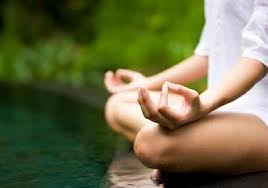Hi Fellow Yogis,
You know when something keeps knocking at your door? A thought, a feeling, reminders or requests?
I always feel that we should respond to persistent nudges, which is why I am hoping to run a ten week course entitled “The Yoga and Mindfulness Path away from Depression and Emotional Distress – Moving Towards the Light”. This course will be an integration of my western Cognitive Behavioural Therapy (CBT) learnings and experience, with Eastern Wisdom gained through my yoga therapy training, yoga teaching, and almost thirty five years of personal yoga practice.
Together, we will find new ways to navigate difficult feelings and emotions. We will practice techniques and practices which will help students to move away from unwanted negative emotions and feelings, towards a more neutral perspective on challenging situations and experiences. We shall explore ways of filling our “happiness pot” and moving out of the shadows and in to the light. 
Students will be given a daily practice to take home with them and this practice will be changed and adapted each week to take account of new learnings and techniques/practices. Together, we will create a safe environment where we can build mutual trust and understanding, and students will be encouraged to positively support each other off their mats as well as on them.
The course will take place on a weekday during the day, venue to be decided. The cost of the full course will be £100, 50% of which will be due on registration and the other 50% before the course begins. Fees include 10 x 75 minute classes, 10 x daily home practice sheets (which will be updated and revised weekly) inclusion in the group support network and the opportunity to tackle emotional issues that are holding you back and preventing you from moving forward towards the sunshine!
There will be a maximum of ten places, and spaces will be allocated on a first come, first served basis.
The course can only happen if there is enough interest, so if you are interested in taking part, please email me at: freetothinkmail@aol.com. I would also be grateful if you would share this with others who you feel might benefit.
Sending warm wishes.
Sarah Kemp



 into account. When, for example, we are
into account. When, for example, we are  ps:
ps: ng heart disease, hypertension, diabetes, osteoporosis and a number of diet-related cancers such as: colon, breast, cervix, gall bladder, ovary, thyroid, kidney, prostate and esophagus. The added benefit of ensuring that you are eating a nutritional diet is that your body will function at its optimal best which means that you will naturally feel better too.
ng heart disease, hypertension, diabetes, osteoporosis and a number of diet-related cancers such as: colon, breast, cervix, gall bladder, ovary, thyroid, kidney, prostate and esophagus. The added benefit of ensuring that you are eating a nutritional diet is that your body will function at its optimal best which means that you will naturally feel better too. e hedge count. Research shows that exercise results in: up to a 35% lower risk of coronary heart disease and stroke; up to a 50% lower risk of type 2 diabetes; up to a 50% lower risk of colon cancer; up to a 20% lower risk of breast cancer; a 30% lower risk of early death and, a 30% lower risk of depression.
e hedge count. Research shows that exercise results in: up to a 35% lower risk of coronary heart disease and stroke; up to a 50% lower risk of type 2 diabetes; up to a 50% lower risk of colon cancer; up to a 20% lower risk of breast cancer; a 30% lower risk of early death and, a 30% lower risk of depression. This is the experience of “losing yourself in the moment” or, as sports players say, “being in the zone.” Pitch the task correctly by choosing something that is challenging but achievable and then lose yourself in it. Immersing yourself in this way allows you to “switch off” from all your everyday concerns and experience a greater enjoyment of life.
This is the experience of “losing yourself in the moment” or, as sports players say, “being in the zone.” Pitch the task correctly by choosing something that is challenging but achievable and then lose yourself in it. Immersing yourself in this way allows you to “switch off” from all your everyday concerns and experience a greater enjoyment of life. n we are more self aware we are naturally better able to make choices that are good for us deep down without being so affected by external influences. Self-awareness builds trust in our own judgement and facilitates a happier level of being.
n we are more self aware we are naturally better able to make choices that are good for us deep down without being so affected by external influences. Self-awareness builds trust in our own judgement and facilitates a happier level of being.


